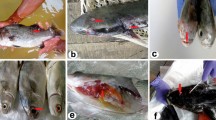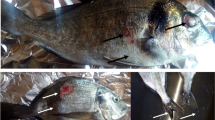Abstract
A 4-year bacteriological survey (2003-2007) of four molluscs cultivated in France and faced with mortality episodes was performed by the French shellfish pathology network. The more abundant bacteria isolated during 92 mortality episodes, occurring mainly in Pacific oyster Crassostrea gigas, were identified by genotyping methods. It allowed us both to confirm the representativeness of Vibrio splendidus and Vibrio aestuarianus bacterial strains and to identify both a large number of Vibrio harveyi-related strains mainly detected during 2007 oyster mortality outbreaks and to a lesser extent bacterial strains identified as Shewanella colwelliana. Because metalloprotease has been reported to constitute a virulence factor in a few Vibrio strains pathogenic for C. gigas, several bacterial strains isolated in this study were screened to evaluate their pathogenicity in C. gigas spat by experimental infection and their ability to produce metalloprotease-like activity in the culture supernatant fluids. A high level (84%) of concordant results between azocaseinase activities and virulence of strains was obtained in this study. Because bacterial metalloprotease activities appeared as a common feature of pathogenic bacteria strains associated with mortality events of C. gigas reared in France, this phenotypic test could be useful for the evaluation of virulence in bacterial strains associated with such mortality episodes.




Similar content being viewed by others
References
Fleury PG, Goyard E, Mazurie J, Claude S, Bouget JF, Langlade A, Le Coguic Y (2001) The assessing of Pacific oyster (Crassostrea gigas) rearing performances by the IFREMER/REMORA network: method and first results (1993–98) in Brittany (France). Hydrobiologia 465:195–208
Saulnier D, De Decker S, Haffner P (2009) Real-time PCR assay for rapid detection and quantification of Vibrio aestuarianus in oyster and seawater: a useful tool for epidemiologic studies. J Microbiol Methods 77:191–197
Garnier M, Labreuche Y, Garcia C, Robert M, Nicolas JL (2007) Evidence for the involvement of pathogenic bacteria in summer mortalities of the Pacific oyster Crassostrea gigas. Microb Ecol 53:187–196
Le Roux F, Gay M, Lambert C, Waechter M, Poubalanne S, Chollet B, Nicolas JL, Berthe F (2002) Comparative analysis of Vibrio splendidus-related strains isolated during Crassostrea gigas mortality events. Aquat Living Resour 15:251–258
Gay M, Renault T, Pons AM, Le Roux F (2004) Two Vibrio splendidus related strains collaborate to kill Crassostrea gigas: taxonomy and host alterations. Dis Aquat Organ 62:65–74
Soletchnik P, Ropert M, Mazurie J, Fleury PG, Le Coz F (2007) Relationships between oyster mortality patterns and environmental data from monitoring databases along the coasts of France. Aquaculture 271:384–400
Goulletquer P, Soletchnik P, Le Moine O, Razet D, Geairon P, Faury N (1998) Summer mortality of the Pacific cupped oyster Crassostrea gigas in the Bay of Marennes-Oleron (France). CM—Int Counc Explor Sea, Cascais (Portugal) 16–19:20
Samain JF, McCombie H (2008) Summer mortality of Pacific oyster Crassostrea gigas. The Morest Project, Editions Quae, 379p
Tubiash HS, Chanley PE, Leifson E (1965) Bacillary Necrosis, a disease of larval and juvenile bivalve mollusks. J Bacteriol 90:1036–1044
Estes R, Friedman C, Elston R, Herwig R (2004) Pathogenicity testing of shellfish hatchery bacterial isolates on Pacific oyster Crassostrea gigas larvae. Dis Aquat Organ 58:223–230
Elston RA, Hasegawa H, Humphrey KL, Polyak IK (2008) Re-emergence of Vibrio tubiashii in bivalve shellfish aquaculture: severity, environmental drivers, geographic extent and management. Dis Aquat Organ 82:119–134
Inamura H, Nakai T, Muroga K (1985) An extracellular protease produced by Vibrio anguillarum. Bulletin of the Japanese Society of Scientific Fisheries 51:1915–1920
Lee KK, Liu PC, Chuang WH (2002) Pathogenesis of gastroenteritis caused by Vibrio carchariae in cultured marine fish. Mar Biotechnol 4:267–277
Lee KK, Chen YL, Liu PC (1999) Hemostasis of Tiger prawn Penaeus monodon affected by Vibrio harveyi, extracellular products, and a toxic cysteine protease. Blood Cells Mol Dis 25:180–192
Lee KK, Yu SR, Liu PC (1997) Alkaline serine protease is an exotoxin of Vibrio alginolyticus in Kuruma prawn, Penaeus japonicus. Curr Microbiol 34:110–117
Nottage AS, Birkbeck TH (1987) Production of proteinase during experimental infection of Ostrea edulis L. larvae with Vibrio alginolyticus NCMB 1339 and the antigenic relationship between proteinases produced by marine vibrios pathogenic for fish and shellfish. J Fish Dis 10:265–273
Travis J, Potempa J, Maeda H (1995) Are bacterial proteinases pathogenic factors? Trends Microbiol 3:405–407
Hase CC, Finkelstein RA (1993) Bacterial extracellular zinc-containing metalloproteases. Microbiol Rev 57:823–837
Miyoshi SI, Shinoda S (2000) Microbial metalloproteases and pathogenesis. Microbs Infect 2:91–98
Labreuche Y, Soudant P, Goncalves M, Lambert C, Nicolas JL (2006) Effects of extracellular products from the pathogenic Vibrio aestuarianus strain 01/32 on lethality and cellular immune responses of the oyster Crassostrea gigas. Dev Comp Immunol 30:367–379
Le Roux F, Binesse J, Saulnier D, Mazel D (2007) Construction of a Vibrio splendidus mutant lacking the metalloprotease gene vsm by use of a novel counterselectable suicide vector. Appl Environ Microbiol 73:777–784
Delston R, Kothary M, Shangraw K, Tall B (2003) Isolation and characterization of a zinc-containing metalloprotease expressed by Vibrio tubiashii. Can J Microbiol 49:525–529
Binesse J, Delsert C, Saulnier D, Champomier-Verges MC, Zagorec M, Munier-Lehmann H, Mazel D, Le Roux F (2008) The metalloprotease Vsm is the main toxic factor for Vibrio splendidus extracellular products. Appl Environ Microbiol 74:7108–7117
Hasegawa H, Lind EJ, Boin MA, Hase CC (2008) The extracellular metalloprotease of Vibrio tubiashii is a major virulence factor for Pacific oyster (Crassostrea gigas) larvae. Appl Environ Microbiol 74:4101–4110
Gay M, Berthe FC, Le Roux F (2004) Screening of Vibrio isolates to develop an experimental infection model in the Pacific oyster Crassostrea gigas. Dis Aquat Organ 59:49–56
Lambert C, Nicolas JL (1998) Specific inhibition of chemiluminescent activity by pathogenic vibrios in hemocytes of two marine bivalves: Pecten maximus and Crassostrea gigas. J Invertebr Pathol 71:53–63
Yamamoto S, Harayama S (1995) PCR amplification and direct sequencing of gyrB genes with universal primers and their application to the detection and taxonomic analysis of Pseudomonas putida strains. Appl Environ Microbiol 61:1104–1109
Chun J, Lee JH, Jung Y, Kim M, Kim S, Kim BK, Lim YW (2007) EzTaxon: a web-based tool for the identification of prokaryotes based on 16S ribosomal RNA gene sequences. Int J Syst Evol Microbiol 57:2259–2261
Hall T (1999) BioitEdit: a user-friendly biological sequence alignment editor and analysis program for Windows 95/98/NT. Nucl Acids Symp Ser 41:95–98
Tamura K, Dudley J, Nei M, Kumar S (2007) MEGA4: Molecular Evolutionary Genetics Analysis (MEGA) Software Version 4.0. Mol Biol Evol 24:1596–1599
Felsenstein J (1985) Confidence limits on phylogenies: an approach using the bootstrap. Evolution 39:783–791
Teo JWP, Zhang LH, Poh CL (2003) Cloning and characterization of a metalloprotease from Vibrio harveyi strain AP6. Gene 303:147
Le Roux F, Gay M, Lambert C, Nicolas JL, Gouy M, Berthe F (2004) Phylogenetic study and identification of Vibrio splendidus-related strains based on gyrB gene sequences. Dis Aquat Organ 58:143–150
Faury N, Saulnier D, Thompson FL, Gay M, Swings J, Le Roux F (2004) Vibrio crassostreae sp. nov., isolated from the haemolymph of oysters (Crassostrea gigas). Int J Syst Evol Microbiol 54:2137–2140
Thompson JR, Pacocha S, Pharino C, Klepac-Ceraj V, Hunt DE, Benoit J, Sarma-Rupavtarm R, Distel DL, Polz MF (2005) Genotypic diversity within a natural coastal bacterioplankton population. Science 307:1311–1313
Sawabe T, Kita-Tsukamoto K, Thompson FL (2007) Inferring the evolutionary history of vibrios by means of multilocus sequence analysis. J Bacteriol 189:7932–7936
Guisande JA, Montes M, Farto R, Armada SP, Perez MJ, Nieto TP (2004) A set of tests for the phenotypic identification of culturable bacteria associated with Galician bivalve mollusc production. J Shellfish R 3:599–609
Weiner RM, Segall AM, Colwell RR (1985) Characterization of a marine bacterium associated with Crassostrea virginica (the Eastern oyster). Appl Environ Microbiol 49:83–90
Colwell RR, Liston J (1960) Microbiology of shellfish. Bacteriological study of the natural flora of Pacific oysters (Crassostrea gigas). Appl Microbiol 8:104–109
Macián M, Garay E, González-Candelas F, Pujalte M, Aznar R (2000) Ribotyping of Vibrio populations associated with cultured oysters (Ostrea edulis). Syst Appl Microbiol 23:409–417
Olafsen JA, Mikkelsen HV, Giæver HM, Høvik Hansen G (1993) Indigenous bacteria in hemolymph and tissues of marine bivalves at low temperatures. Appl Environ Microbiol 59:1848–1854
Ortigosa M, Garay E, Pujalte MJ (1994) Numerical taxonomy of Vibrionaceae isolated from oysters and seawater along an annual cycle. Syst Appl Microbiol 17:216–225
Pujalte MJ, Ortigosa M, Macián MC, Garay E (1999) Aerobic and facultative anaerobic heterotrophic bacteria associated to Mediterranean oysters and seawater. Int Microbiol 2:259–266
Labreuche Y (2006) Caractérisation de la virulence d'une souche de Vibrio aestuarianus, pathogène de l'huître creuse Crassostrea gigas. Université de Bretagne Occidentale, Brest, France, PhD, 277p
Labreuche Y, Lambert C, Soudant P, Boulo V, Huvet A, Nicolas JL (2006) Cellular and molecular hemocyte responses of the Pacific oyster, Crassostrea gigas, following bacterial infection with Vibrio aestuarianus strain 01/32. Microbs Infect 8:2715–2724
Nicolas JL, Corre S, Gauthier G, Robert R, Ansquer D (1996) Bacterial problems associated with scallop Pecten maximus larval culture. Dis Aquat Organ 27:67–76
Gomez-Leon J, Villamil L, Lemos ML, Novoa B, Figueras A (2005) Isolation of Vibrio alginolyticus and Vibrio splendidus from aquacultured carpet shell clam (Ruditapes decussatus) larvae associated with mass mortalities. Appl Environ Microbiol 71:98–104
Travers MA, Le Goïc N, Huchette S, Koken M, Paillard C (2008) Summer immune depression associated with increased susceptibility of the European abalone, Haliotis tuberculata to Vibrio harveyi infection. Fish Shellfish Immunol 25:800–808
Nicolas JL, Basuyaux O, Mazurié J, Thébault A (2002) Vibrio carchariae, a pathogen of the abalone Haliotis tuberculata. Dis Aquat Organ 50:35–43
Chang AK, Kim HY, Park JE, Acharya P, Park IS, Yoon SM, You HJ, Hahm KS, Park JK, Lee JS (2005) Vibrio vulnificus secretes a broad-specificity metalloprotease capable of interfering with blood homeostasis through prothrombin activation and fibrinolysis. J Bacteriol 187:6909–6916
Denkin SM, Nelson DR (2004) Regulation of Vibrio anguillarum empA metalloprotease expression and its role in virulence. Appl Environ Microbiol 70:4193–4204
Takahashi KG, Nakamura A, Mori K (2000) Inhibitory effects of ovoglobulins on bacillary necrosis in larvae of the Pacific oyster, Crassostrea gigas. J Invertebr Pathol 75:212–217
Watanabe H, Miyoshi SI, Kawase T, Tomochika KI, Shinoda S (2004) High growing ability of Vibrio vulnificus biotype 1 is essential for production of a toxic metalloprotease causing systemic diseases in humans. Microb Pathog 36:117–123
Kim C-M, Kang S-M, Jeon H-J, Shin S-H (2007) Production of Vibrio vulnificus metalloprotease VvpE begins during the early growth phase: usefulness of gelatin-zymography. J Microbiol Methods 70:96–102
Milton DL, Norqvist A, Wolf-Watz H (1992) Cloning of a metalloprotease gene involved in the virulence mechanism of Vibrio anguillarum. J Bacteriol 174:7235–7244
Le Roux F, Mohamed Z, Chakroun N, Binesse J, Saulnier D, Bouchier C, Zidane N, Ma L, Rusniok C, Lajus A, Buchrieser C, Médigue C, Polz MF, Mazel D (2009) Genome sequence of Vibrio splendidus: an abundant planctonic marine species with a large genotypic diversity. Environ Microbiol 11:1959–1970
Acknowledgments
We thank Helen McCombie for her help with English editing.
Author information
Authors and Affiliations
Corresponding author
Rights and permissions
About this article
Cite this article
Saulnier, D., De Decker, S., Haffner, P. et al. A Large-Scale Epidemiological Study to Identify Bacteria Pathogenic to Pacific Oyster Crassostrea gigas and Correlation Between Virulence and Metalloprotease-like Activity. Microb Ecol 59, 787–798 (2010). https://doi.org/10.1007/s00248-009-9620-y
Received:
Accepted:
Published:
Issue Date:
DOI: https://doi.org/10.1007/s00248-009-9620-y




